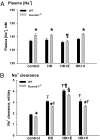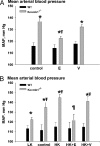Hypertension of Kcnmb1-/- is linked to deficient K secretion and aldosteronism
- PMID: 19556540
- PMCID: PMC2701967
- DOI: 10.1073/pnas.0904635106
Hypertension of Kcnmb1-/- is linked to deficient K secretion and aldosteronism
Abstract
Mice lacking the beta1-subunit (gene, Kcnmb1; protein, BK-beta1) of the large Ca-activated K channel (BK) are hypertensive. This phenotype is thought to result from diminished BK currents in vascular smooth muscle where BK-beta1 is an ancillary subunit. However, the beta1-subunit is also expressed in the renal connecting tubule (CNT), a segment of the aldosterone-sensitive distal nephron, where it associates with BK and facilitates K secretion. Because of the correlation between certain forms of hypertension and renal defects, particularly in the distal nephron, it was determined whether the hypertension of Kcnmb1(-/-) has a renal origin. We found that Kcnmb1(-/-) are hypertensive, volume expanded, and have reduced urinary K and Na clearances. These conditions are exacerbated when the animals are fed a high K diet (5% K; HK). Supplementing HK-fed Kcnmb1(-/-) with eplerenone (mineralocorticoid receptor antagonist) corrected the fluid imbalance and more than 70% of the hypertension. Finally, plasma [aldo] was elevated in Kcnmb1(-/-) under basal conditions (control diet, 0.6% K) and increased significantly more than wild type when fed the HK diet. We conclude that the majority of the hypertension of Kcnmb1(-/-) is due to aldosteronism, resulting from renal potassium retention and hyperkalemia.
Conflict of interest statement
The authors declare no conflict of interest.
Figures







References
-
- Fardella CE, et al. Primary hyperaldosteronism in essential hypertensives: Prevalence, biochemical profile, and molecular biology. J Clin Endocrinol Metab. 2000;85:1863–1867. - PubMed
-
- Olivieri O, et al. Menopause not aldosterone-to-renin ratio predicts blood pressure response to a mineralocorticoid receptor antagonist in primary care hypertensive patients. Am J Hypertens. 2008;21:976–982. - PubMed
-
- Young WF. Primary aldosteronism: Renaissance of a syndrome. Clin Endocrinol (Oxf) 2007;66:607–618. - PubMed
-
- Gollasch M, et al. Ontogeny of local sarcoplasmic reticulum Ca2+ signals in cerebral arteries: Ca2+ sparks as elementary physiological events. Circ Res. 1998;83:1104–1114. - PubMed
-
- Jaggar JH, Stevenson AS, Nelson MT. Voltage dependence of Ca2+ sparks in intact cerebral arteries. Am J Physiol Cell Physiol. 1998;274:C1755–C1761. - PubMed
Publication types
MeSH terms
Substances
Grants and funding
LinkOut - more resources
Full Text Sources
Other Literature Sources
Medical
Molecular Biology Databases

